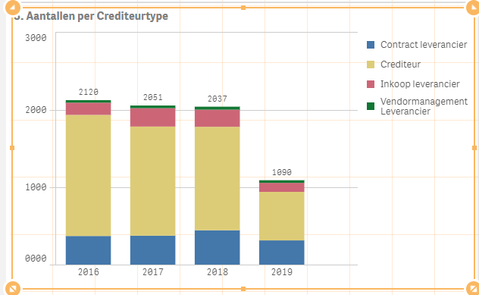Unlock a world of possibilities! Login now and discover the exclusive benefits awaiting you.
- Qlik Community
- :
- Forums
- :
- Analytics
- :
- App Development
- :
- Wrong result Count distinct after split of data
- Subscribe to RSS Feed
- Mark Topic as New
- Mark Topic as Read
- Float this Topic for Current User
- Bookmark
- Subscribe
- Mute
- Printer Friendly Page
- Mark as New
- Bookmark
- Subscribe
- Mute
- Subscribe to RSS Feed
- Permalink
- Report Inappropriate Content
Wrong result Count distinct after split of data
We have the following bar chart:
Dimensions are YEAR en TYPE CREDITOR, Meassure is a Distinct count of the CREDITOR NUMBERS.
In Qlik we want to spit a certain type ("Crediteur" - 1564 items).
We do this by making a new masteritem (dimension) with the following expression:
=if ([CRED_DIM_TYPE_CREDITEUR] = 'Crediteur',
if(Match(ID_CATEGORIE_LEVEL_3, 'HR.07.02','HR.07.03','HR.13.03','HR.13.02','HR.09.06',
'FAC.06.01','FAC.06.02','FAC.03.03','AM.07.10','HR.08.03',
'FAC.06.03','HR.06.01'),'Geaccepteerde crediteur','Niet Geaccepteerde Crediteur'),
CRED_DIM_TYPE_CREDITEUR)
When we change the the dimension of the chart to this new one we get:
The result of the Count Distinct is different, while the source data is not changed.
We see 1564 items for "Niet Geaccepteerde crediteur" in stead of 1212
352 items for "Geaccepteerde crediteur" are correct.
1564-352 =1212
So it seems like the split does not work in our bar chart
- Tags:
- bar chart
Accepted Solutions
- Mark as New
- Bookmark
- Subscribe
- Mute
- Subscribe to RSS Feed
- Permalink
- Report Inappropriate Content
Solved; Used a wrong field in the creation of the dimension.
- Mark as New
- Bookmark
- Subscribe
- Mute
- Subscribe to RSS Feed
- Permalink
- Report Inappropriate Content
I would expect count distinct to produce different results if you change the dimension. The coarser bucket may land up ignoring a duplicate which is not duplicated in the finer resolution buckets. So the finer the granularity, the higher the total of the distinct count will be.
- Mark as New
- Bookmark
- Subscribe
- Mute
- Subscribe to RSS Feed
- Permalink
- Report Inappropriate Content
I don't understand what u mean;
for example:
100 unique creditors have type A
I split type A in 50 type A1 and 50 Type A2
I still have to have 100 unique creditors.
- Mark as New
- Bookmark
- Subscribe
- Mute
- Subscribe to RSS Feed
- Permalink
- Report Inappropriate Content
Solved; Used a wrong field in the creation of the dimension.

